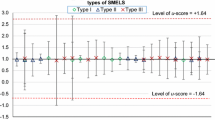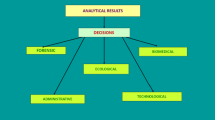Abstract
We propose that several different reactor irradiation times followed by assaying of activity for differential counting periods may be employed for quality control (QC) of neutron activation analysis (NAA) data of biological samples. It is also recommended that three to four reference materials (RMs) of similar matrix but from different agencies such as National Institute of Standards and Technology (NIST, USA), International Atomic Energy Agency (IAEA, Vienna), Institute of Nuclear Chemistry and Technology (INCT, Poland), and National Institute of Environmental Studies (NIES, Japan) including a synthetic multielemental primary standard should always be analyzed simultaneously along with the samples. Finally, the mean ± σ values so obtained may be considered as more reliable after statistical analysis. Our analytical data for Na and K in three RMs (SRM 1572, CRM H-9, and Bowen’s Kale) using different irradiation periods of 15 m, 2 h, 6 h, and 1 day were comparable with the certified values within error range of + 0.2 to − 2.7%. We report our data for 20 elements in two candidate RMs corn flour (INCT-CF-3) and soya bean flour (INCT-SBF-4) from the INCT, Poland, where Z-score values for most elements are in reasonable range of certified values.

Similar content being viewed by others
Data Availability
All data generated or analyzed in this study are contained within this article.
References
IAEA Tecdoc 1350 2003 Development and use of reference materials and quality control materials International Atomic Energy Agency Vienna 113
Bode P (1995) Quality measurement and laboratory accreditation at a university: what can be learned from experience. Analyst 120:1527–1533
Emons E, Held A, Ulberth F (2006) Reference materials as crucial tools for quality assurance and control in food analysis. Pure Appl Chem 78:135–143. https://doi.org/10.1351/pac200678010135
Byrne AR (1994) Some improvements in the quality of NAA procedures and the reliability of the analytical results. In Kucera J, Obrusnik I, Sabbioni E (eds) Nuclear analytical methods in life sciences, Humana Press, Totowa, NJ. pp 529–537. https://doi.org/10.1007/BF02917356
Einax JW, Reichenbacher M (2006) Solution to quality assurance challenge 2. Anal Bioanal Chem 384:14–18. https://doi.org/10.1007/s00216-005-0195-2
Dybczynski RS (2019) The role of NAA in securing the accuracy of analytical results in the inorganic trace analysis. J Radioanal Nucl Chem 322:1505–1515. https://doi.org/10.1007/s10967-019-06675-7
Garg AN, Kumar A, Nair AGC, Reddy AVR (2007) Analysis of some Indian medicinal herbs. J Radioanal Nucl Chem 271:611–619. https://doi.org/10.1007/s10967-007-0316-9
Choudhury RP, Reddy AVR, Garg AN (2007) Availability of essential elements in nutritional supplements used as antidiabetic herbal formulations. Biol Trace Elem Res 120:148–162. https://doi.org/10.1007/s12011-007-8022-6
Begaa S, Messaoudi M (2019) Toxicological aspect of some selected medicinal plant samples collected from Djelfa, Algeria region. Biol Trace Elem Res 187:301–306. https://doi.org/10.1007/s12011-018-1365-3
Singh V, Garg AN (2006) Availability of essential trace elements in Indian cereals, vegetables and spices using INAA and the contribution of spices to daily dietary intake. Food Chem 94:81–89. https://doi.org/10.1016/j.foodchem.2004.10.053
Rahman M, Islam MA, Khan RA (2018) Characterization of chemical elements in common spices of Bangladesh for dietary intake and possible health risk assessment by INAA and AAS techniques. J Radioanal Nucl Chem 318:1347–1357. https://doi.org/10.1007/s10967-018-6222-5
Messaoudi M, Benerfa A, Ouakouak H, Begaa S (2022) Determination of some chemical elements of some common spices used by Algerians and possible health risk assessment. Biol Trace Elem Res 200:2498–2509. https://doi.org/10.1007/s12011-021-02819-9
Messaoudi M, Begaa S (2019) Dietary intake and content of same micronutrients and toxic elements in two Algerian spices (Corriandrum sativum L. and Cuminum cyminum L.). Biol Trace Elem Res 188:508–513. https://doi.org/10.1007/s12011-018-1417-8
Datta A, Garg AN, Sharma V, Acharya R (2020) Quantification of minor and trace elements in raw and branded turmeric samples using Instrumental Neutron Activation Analysis utilizing Apsara-U reactor for possible applications to forensic science. J Radioanal Nucl Chem 325:967–975. https://doi.org/10.1007/s10967-020-07287-2
Wenclawiak BW, Koch M, Hadjicostas E (2004) (eds) Quality assurance in analytical chemistry. Springer-Verlag, Germany
Garg AN, Kumar A, Choudhury RP (2007) Phosphorus in biological standards and samples by thermal neutron irradiation and β counting. J Radioanal Nucl Chem 271:481–488. https://doi.org/10.1007/s10967-007-0234-x
Singh V, Garg AN (1997) Availability of essential trace elements in Ayurvedic Indian medicinal herbs using instrumental neutron activation analysis. Appl Radiat Isot 48:97–101. https://doi.org/10.1016/s0969-8043(96)00043-7
Begaa S, Messaoudi M, Benerfa A (2021) Statistical approach and neutron activation analysis for determining essential and toxic elements in two kinds of Algerian Artemisea plant. Biol Trace Elem Res 199:2399–2405. https://doi.org/10.1007/12011-020-02358-7
Chutke NL, Ambulkar MN, Aggarwal AL, Garg AN (1996) Instrumental neutron activation analysis of ambient air dust particulates from metropolitan cities in India. Environ Pollution 85:67–76. https://doi.org/10.1016/0269-7491(94)90239-9
NIST (1982) Certificate of analysis, citrus leaves SRM-1572. National Institute of Standards and Technology, Gaithersburg, MD, USA, p 3
Parr RM (1988) On the role of neutron activation analysis in the certification of a new reference material for trace element studies, mixed human diet, H-9. J Radioanal Nucl Chem 123:259–271. https://doi.org/10.1007/BF02036396
Bowen HJM (1967) Comparative elemental analyses of a standard plant material. Analyst 92:124–131
Bowen HJM (1985) Kale as a reference material. In: Wolf WR (ed) Biological reference materials: availability, uses and need for validation of nutrient measurements. John Wiley & Sons, New York, pp 3–17
Polkowska-Motrenko H, Dybczynski RS, Chajduk E, Danko B, Kulisa K, Samczynski Z, Sypula M, Szopa Z (2007) New Polish certified reference materials for inorganic trace analysis: corn flour (INCT-CF-3) and soya bean flour (INCT-SBF-4). Chem Anal (Warsaw) 52:361–376
NIST (1988) Certificate of analysis, rice flour SRM-1568a. National Institute of Standards and Technology, Gaithersburg, MD, USA p.4
NIST (1988) Certificate of analysis, wheat flour SRM-1567. National Institute of Standards and Technology, Gaithersburg, MD, USA p.3
Peng L, Tian W (1993) Instrumental neutron activation analysis of RM IAEA-155 Whey Powder. Nucl Sci Tech 4:108–113
Suzuki S, Hirai S (1990) Determination of trace elements in NIES standard reference materials by instrumental neutron activation analysis. Musashi Kogyo Daigaku Genshiryoku Kenkyusho Kenkyu Shoho 16:82–87
Garg AN, Choudhury RP, Acharya R, Reddy AVR (2012) Determination of minor, trace and toxic elements in chewing tobacco products by instrumental neutron activation analysis and identification glutamic acid. J Radioanl Nucl Chem 294:197–202. https://doi.org/10.1007/s10967-012-1845-4
Garg AN, Gajbhiye PT, Choudhury RP (2017) INAA of essential micronutrients in Terminalia arjuna bark powder: a versatile heart tonic. J Radioanal Nucl Chem 314:1539–1545. https://doi.org/10.1007/s10967-017-5564-8
Acknowledgements
Grateful thanks are due to Board of Research in Nuclear Science (Department of Atomic Energy, Government of India) for grants-in-aid at RTM Nagpur University, Nagpur (37/13/91-G) and Indian Institute of Technology, Roorkee (2000/37/5/BRNS). RPC is thankful to MHRD for grant of research fellowship. Our sincere thanks to Drs SB Manohar, AVR Reddy, and R Acharya for providing irradiation and counting facilities at the Radiochemistry Division, BARC, Mumbai.
Author information
Authors and Affiliations
Contributions
ANG—conceptualization, planning, project management, editing, and reviewing including overall supervision.
VS—sample collection, preparation for irradiation, experimental work at BARC, Mumbai, data compilation, statistical analysis, and draft writing.
RPC—sample preparation for irradiation, experimental work at BARC, Mumbai, data compilation, statistical analysis, and draft writing.
Corresponding author
Ethics declarations
Competing interests
The authors declare no competing interests.
Consent for Publication
The research work presented in this article is original and is not submitted/presented anywhere else in any form for consideration of publication. It has consent of all the authors.
Conflict of Interest
The authors declare no competing interests.
Additional information
Publisher's Note
Springer Nature remains neutral with regard to jurisdictional claims in published maps and institutional affiliations.
Supplementary Information
Below is the link to the electronic supplementary material.
Rights and permissions
About this article
Cite this article
Garg, A.N., Singh, V. & Choudhury, R.P. Use of Multiple Irradiations and Reference Materials as Comparators in Quality Control of Neutron Activation Analysis Data of Biological Samples. Biol Trace Elem Res 201, 2674–2681 (2023). https://doi.org/10.1007/s12011-022-03340-1
Received:
Accepted:
Published:
Issue Date:
DOI: https://doi.org/10.1007/s12011-022-03340-1




